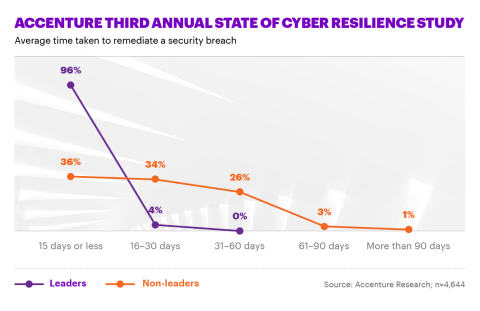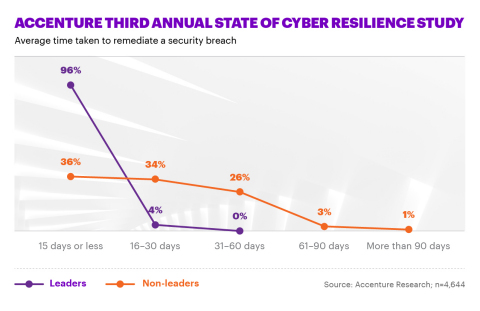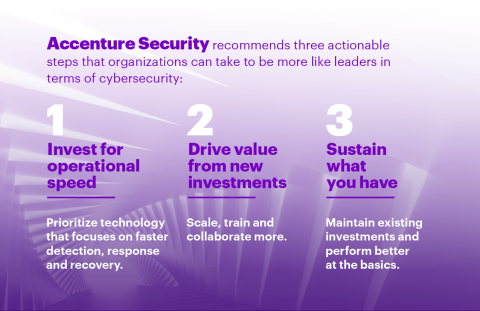NEW YORK--(BUSINESS WIRE)--Despite higher levels of investment in advanced cybersecurity technologies over the past three years, less than one-fifth of organizations are effectively stopping cyberattacks and finding and fixing breaches fast enough to lower the impact, according to a new report from Accenture (NYSE: ACN).
Based on a survey of more than 4,600 enterprise security practitioners around the globe, Accenture’s Third Annual State of Cyber Resilience study explores the extent to which organizations prioritize security, the effectiveness of current security efforts, and the impact of new security-related investments.
From detailed modeling of cybersecurity performance, the study identified a group of elite “leaders” — 17% of the research sample — that achieve significantly better results from their cybersecurity technology investments than other organizations. Leaders were characterized as among the highest performers in at least three of the following four categories: stop more attacks, find breaches faster, fix breaches faster and reduce breach impact. The study identified a second group, comprising 74% of the respondents, as “non-leaders” — average performers in terms of cyber resilience but far from being laggards.
“Our analysis identifies a group of standout organizations that appear to have cracked the code of cybersecurity when it comes to best practices,” said Kelly Bissell, who leads Accenture Security globally. “Leaders in our survey are far quicker at detecting a breach, mobilizing their response, minimizing the damage and getting operations back to normal.”
For instance, leaders were four times more likely than non-leaders to detect a breach in less than one day (88% vs. 22%). And when defenses fail, nearly all (96%) of the leaders fixed breaches in 15 days or less, on average, whereas nearly two-thirds (64%) of non-leaders took 16 days or longer to remediate a breach — with nearly half of those taking more than a month.
“When a cyberattack prevents a pharmaceutical company from manufacturing drugs or a ship from docking at port — those are the kinds of crippling business impacts we’re most concerned about helping our clients avoid,” said Ryan LaSalle, who leads Accenture Security in North America. “If investments in technology don't hit the mark when it comes to defending against cyberattacks, C-suite executives are not only jeopardizing their operations and finances but their brands and reputations as well.”
Among the key differences in cybersecurity practices between leaders and non-leaders, the report identified:
- Leaders focused more of their budget allocations on sustaining what they already have, whereas the non-leaders place significantly more emphasis on piloting and scaling new capabilities.
- Leaders were nearly three times less likely to have had more than 500,000 customer records exposed through cyberattacks in the last 12 months (15% vs. 44%).
- Leaders were more than three times as likely to provide users of security tools with required training for those tools (30% vs. 9%).
The study also found that more than four in five respondents (83%) believe that organizations need to think beyond securing just their own enterprises and take better steps to secure their vendor ecosystems. Additionally, while cybersecurity programs designed to protect data and other key assets are only actively protecting about 60% of an organization’s business ecosystem, which includes vendors and other business partners, 40% of breaches come through this route.
“The sizable number of vendor relationships that most organizations have poses a significant challenge to their ability to monitor that business ecosystem,” Bissell said. “Yet, given the large percentage of breaches that originate in an organization’s supply chain, companies need to ensure that their cyber defenses stretch beyond their own walls.”
To learn more about the research, download the Third Annual State of Cyber Resilience study here.
Methodology
Accenture Research surveyed 4,644 executives representing companies with annual revenues of at least US$1 billion in 24 industries and 16 countries across North and South America, Europe and Asia Pacific. Nearly all respondents (98%) were the sole or key decision-maker regarding their organization’s cybersecurity strategy and spending. The study was fielded from April to May 2019.
About Accenture
Accenture is a leading global professional services company, providing a broad range of services and solutions in strategy, consulting, digital, technology and operations. Combining unmatched experience and specialized skills across more than 40 industries and all business functions — underpinned by the world’s largest delivery network — Accenture works at the intersection of business and technology to help clients improve their performance and create sustainable value for their stakeholders. With 505,000 people serving clients in more than 120 countries, Accenture drives innovation to improve the way the world works and lives. Visit us at www.accenture.com.
Accenture Security helps organizations build resilience from the inside out, so they can confidently focus on innovation and growth. Leveraging its global network of cybersecurity labs, deep industry understanding across client value chains and services that span the security lifecycle, Accenture protects organizations’ valuable assets, end-to-end. With services that include strategy and risk management, cyber defense, digital identity, application security and managed security, Accenture enables businesses around the world to defend against known sophisticated threats, and the unknown. Follow us @AccentureSecure on Twitter or visit us at www.accenture.com/security.
Copyright © 2020 Accenture. All rights reserved. Accenture and its logo are trademarks of Accenture. The information in this press release and the “Third Annual State of Cyber Resilience” study is general in nature and does not consider the specific needs of your IT ecosystem and network, which may vary and require unique action. As such, all information is provided on an “as-is” basis without representation or warranty, and the reader is responsible for determining whether to follow any of the suggestions, recommendations or potential mitigations at their own discretion. Accenture accepts no liability for any action or failure to act in response to the information contained or referenced in this press release or the mentioned report.



